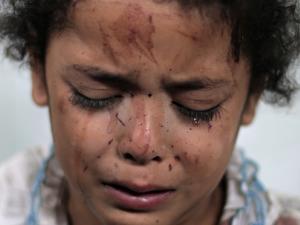
Gaza & Operation Protective Edge – One Year Later
Three Israelis boys trekking home in the West Bank are reported missing and presumed dead by Israeli security forces and the prime minister. A recording of a distressed telephone call made by one of the boys reveals sounds of gun shots followed by the pained cries of the three boys. Their blood is found in the car of the suspected Palestinians behind the kidnapping and murder.
An 18-day hunt for the boys’ bodies is officially described as a rescue mission as the political leadership and IDF general staff assure a worried public that they believe the boys are alive and the information about the phone call and blood are censored. The IDF sweeps the West Bank rounding up hundreds of Hamas officials. The official rationale is that Hamas is the culprit behind the kidnapping. Hamas denies the accusation and while the suspects are affiliated with Hamas, they belong to a family with a history of unilateral conduct. Many observers assume Israel’s political leadership knowns as much, but has seized an opportunity to detain Hamas members under the cover of police action. A corollary objective would be scuttling the recently signed unity deal between Hamas and its rival Fatah, which was opposed by the Israeli government.
The boys turn up dead. The Israeli public is too aggrieved to focus on whether the official story of a rescue mission was a falsehood. Instead the public turns to grief and, for some, vengeance. A Palestinian boy is kidnapped in Jerusalem, his body immolated and left for dead in a park. Israelis are found to have been behind the murder. The death of the Palestinian boy sparks protests in East Jerusalem and clashes with Israeli police, who are filmed harshly attacking the cousin of the deceased boy.
In Gaza, meanwhile, militants seize on the escalating tensions, the death of a Palestinian boy, and the arrests of their fellow Islamist partisans to fire homemade rockets into Israel. Although not controlled by Hamas, the IDF holds the organization responsible and fires missiles at Hamas installations. Several Hamas members are killed and the organization decides to strike back. Thus began the summer war between Israel and Hamas. By its end – after 51 days – over 2,200 Palestinians and 69 Israelis had been killed, of the former a majority were civilians (over 500 children) and of the latter all but five were soldiers. While Israel’s Iron Dome system shielded Israelis from whatever harm Hamas’ crude rockets posed, the Gaza Strip was devastated by the IDF’s missile and artillery barrages. Over 15,000 Palestinian homes were damaged if not leveled.
Today, the Institute for Palestine Studies is presenting a retrospective on Operation Protective Edge. This includes our Special Focus: Gaza Under Attack with feature articles* from the Journal of Palestine Studies that provide a background on Gaza’s predicament as a besieged territory subject to recurring Israeli onslaughts and nearly decade-long blockade.
In addition, we’ve also made available several articles from the Journal of Palestine Studies Special Issue: Operation Protective Edge (JPS 173, Vol. 44, No. 1 Autumn 2014). And, lastly, an exclusive article by Palestine Studies Fellow Muhammad Ali Khalidi, “Does Israel Target Civilians?”
This collection provides an in-depth overview of the war, its conduct and consequences; along with an analysis of American public opinion and media reporting of the conflict.
*Articles that were only made available as part of our monthly Special Focus have since been removed and may be purchased at our co-publisher's website, the University of California Press. Removed articles will automatically take you to the respective article at UCP's website.
Special Focus – Gaza Under Attack: JPS and News Articles
Palestine Studies Video - The World Reacts to Operation Protective Edge in Gaza
Muhammad Ali Khalidi, “Does Israel Target Civilians?”
Journal of Palestine Studies Special Issue: Operation Protective Edge:
Author: Jean-Pierre Filiu
Journal of Palestine Studies, Vol. 44, No. 1, SPECIAL ISSUE: OPERATION PROTECTIVE EDGE (Autumn 2014), pp. 52-60
Politicide in Gaza: How Israel's Far Right Won the War
Author: Max Blumenthal
Journal of Palestine Studies, Vol. 44, No. 1, SPECIAL ISSUE: OPERATION PROTECTIVE EDGE (Autumn 2014), pp. 14-28
Author: Robin D.G. Kelley
Journal of Palestine Studies, Vol. 44, No. 1, SPECIAL ISSUE: OPERATION PROTECTIVE EDGE (Autumn 2014), pp. 29-41
The Implications of Joining the ICC after Operation Protective Edge
Author: Victor Kattan
Journal of Palestine Studies, Vol. 44, No. 1, SPECIAL ISSUE: OPERATION PROTECTIVE EDGE (Autumn 2014), pp. 61-73
The Dahiya Doctrine, Proportionality, and War Crimes
By Rashid I. Khalidi
Journal of Palestine Studies, Vol. 44, No. 1, SPECIAL ISSUE: OPERATION PROTECTIVE EDGE (Autumn 2014), pp. 5-13
INTERVIEW WITH NOURA ERAKAT: Framing the Palestinian Narrative
Interviewed by Nehad Khader
Journal of Palestine Studies, Vol. 44, No. 1, SPECIAL ISSUE: OPERATION PROTECTIVE EDGE (Autumn 2014), pp. 106-117
Update on Conflict and Diplomacy: 16 MAY–15 AUGUST 2014
Author: Ben White
Journal of Palestine Studies, Vol. 44, No. 1, SPECIAL ISSUE: OPERATION PROTECTIVE EDGE (Autumn 2014), pp. 204-237
Compiled by Ben White
Journal of Palestine Studies, Vol. 44, No. 1, SPECIAL ISSUE: OPERATION PROTECTIVE EDGE (Autumn 2014)
Documents and Source Material:
UN HUMAN RIGHTS COUNCIL (UNHRC), RESOLUTION ON THE SITUATION IN GAZA, GENEVA, 23 JULY 2014
UN SECURITY COUNCIL (UNSC), PRESIDENTIAL STATEMENT ON THE SITUATION IN GAZA, NEW YORK, 28 JULY 2
UNRWA, PRESS RELEASE ON SHELLING OF UNRWA-RUN SCHOOL, JERUSALEM, 30 JULY 2014
PEW RESEARCH CENTER, POLL ON MIDDLE EAST SYMPATHIES, WASHINGTON, DC, 28 JULY 2014
PRESIDENT BARACK OBAMA, PRESS BRIEFING ON GAZA, WASHINGTON, DC, 1 AUGUST 2014
Research and scholarship requires investment. Generous contributions from people like you allow us to provide invaluable resources as a public good. Make a tax-deductible donation today!
Photo Credit: Khalil Hamra/AP

